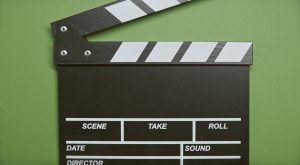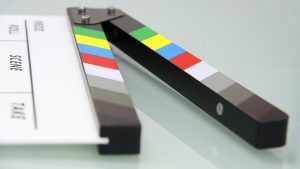What is a clapper board used for in movies?
You’ve probably seen the “behind the scenes” on a movie and seen them use these weird-looking plate things and they smack these sticks together. What do they do and what kind of service do they provide on a production?
That can be summed up to the early days of making films back before they were using these older forms of slate boards or clapper boards, there was an even older form that they used to use. Especially right when they started working with sound.
In film production, there was one person that held the slate board itself and then there was another person, when they had the introduction of sound, they would have two sticks and would just clap. The reason why there is that clap sound is that whenever the editor is going through the audio there is a loud peak. It will make a big spike that is easy to see so you can see where each scene needs to be cut.
They do come with a time code synchronization that you can use to synchronize everything in post to make it easier on your editor. Or if you’re the one editing the video it makes it a little bit easier and ties everything together so you don’t have to go looking around for where all these shots and scenes had started.

Is using a clap award something you need to use especially if you’re someone that’s like a YouTuber? Honestly no… The only time you need one of these is when you’re working on a big production or something that has a lot of scenes like a feature-length film. And maybe you don’t remember where everything’s going or you’re sending these off to another editor that’s going to be editing everything together… It makes it a little bit easier to let them know where everything is especially if they were someone that wasn’t there when everything was being shot.
What are the things that are usually written on these boards? The more modern one has a cell for the roll. This was typically used for film cameras where you’d say what role of the film canister that you’re using however, with most of these modern cameras we’re using memory cards you can say which card you’re actually using on it.
It has another spot for the scene, so which scene in this feature are you actually shooting. The other one is the take, so how many takes are you on for this particular scene. Next, you have the production, so the production company or the producer. You also have a spot for the director, who’s the director on it.

You also have the camera this is great if you are on a production that has multiple cameras in use so you know exactly what camera is being used in that shot, which is great for someone who is editing. Especially someone that is editing with color grading in mind. They have to know what camera they are color grading for.
There’s also fps, which stands for frames per second. Most films are shot at 24 frames per second or 23.98, but there are certain cases where the frames per second may be changed. Like if it’s something for tv it might be shot at 30 frames a second. If it’s something for sports it might be 50 or 60 frames per second, or if it’s something that’s more action-packed it will be shot at 60 frames. However, a slow-motion shot is going to be shot at a way faster frame rate, sometimes like 240 or higher.
Then you have your date, you have spots to circle if it was an interior shot an exterior shot, if it was shot for daytime night time now you also have sync and MOS sync. This is if you’re going to have your audio and video recorded separately so that whoever’s looking at this to edit it they know that they have to sync this in post.
Finally have MOS which is an abbreviation for motor only shot which was a term for back whenever they used to use film cameras primarily and it pretty much just means that it is a video only shot there’s no audio being recorded for this particular scene now there are tons of other types of slate boards and clapper boards out there that have different things you can fill in and ones that have less things that you can fill in if that’s something that’s a little bit less intimidating for you this one holds up pretty well you can pick it up on amazon i think i got this one for like 25 dollars they’re not that expensive but like i said you really only need this if you’re on a bigger production if you have multiple people working on it with multiple cameras different types of scenes going on it can help organize things a lot better so it is a great organizational tool when it comes to film production a fun fact is it’s usually just one person’s job and their only job to manage the slate board of the clapper board it’s their job to go between takes and between shots to write everything out to make sure everything on there is correct it’s a real important job because if they get something wrong when it comes to the edit it can really screw some things up or just make things take way longer than they should so if you are planning on using one of these make sure you’re doing everything in correct order it really helps if you have a shot list with you just so you can make sure that you’re doing everything correctly maybe you’re someone that has a string of shots all together on one single video and there was no clapperboard no slateboard no way to see when the scenes were cut well check out this video and i’ll show you exactly how to use davinci resolve to find where all the scenes are